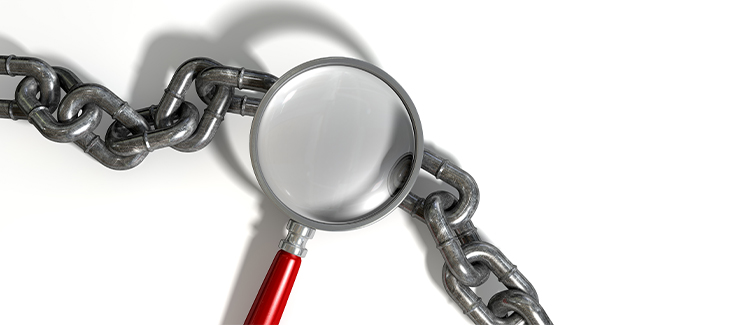The Centers for Disease Control and Prevention (CDC) reports, “On any given day, about 1 in 31 hospital patients has at least one healthcare-associated infection.” That means that about three percent of all hospital patients acquire a healthcare-associated infection, also called an HAI. These patients sought medical care to improve their health, but mistakes were made, and they wound up having to pay the consequences.
When a patient contracts an HAI, it cannot simply be swept under the rug. The cause and source of the infection must be ascertained, and quickly to avoid the possibility of another patient having the same experience. The CDC explains that HAIs "… can spread between patients, providers, staff and visitors through unclean hands or improper use or reuse of equipment.” To effectively get answers and proactively prevent such incidents from happening again, an investigation must occur, and a series of five “Why” questions must be answered.
1) Why did the patient acquire an HAI?
We have to begin by answering the most basic question. The patient acquired an HAI because they were exposed to a harmful pathogen during their stay. The presence of these pathogens in a healthcare environment underscores the importance of stringent hygiene and disinfection protocols. This highlights a serious problem necessitating a thorough search to identify specific failures and implement corrective actions to safeguard patient health and prevent similar occurrences in the future.
2) Why was the patient exposed to the pathogen?
The next answer will be a little harder to ascertain. Pathogens can be transmitted in various ways, such as through unclean hands of healthcare providers, contaminated medical equipment, or inadequately sanitized surfaces. Reusable medical devices, such as transesophageal echocardiogram (TEE), transvaginal, transrectal, or even surface ultrasound probes, can often be the culprits when it comes to the spread of an HAI. Suppose one of these ultrasound probes is used on a patient with a communicable disease. In that case, that probe will become infected with bacteria, which, if not properly reprocessed, may infect another unsuspecting patient. In this example, the patient was exposed to a pathogen because the pathogen was present on a piece of medical equipment used on the patient.
3) Why was the pathogen present on the ultrasound probe?
The pathogen was present because the probe was not properly reprocessed before reuse. Inadequate cleaning and high-level disinfection can occur due to human error, such as improper handling or incorrect reprocessing techniques. They can also be a consequence of using outdated methods of reprocessing. Manual cleaning processes are particularly prone to variability and inconsistency, leading to potential lapses where pathogens are not fully eliminated. Cracks, crevasses, and differing probe designs can increase the likelihood of ultrasound probes not being effectively manually cleaned. As we are all human, different Instructions for Use (IFUs) for each probe manufacturer only increase the potential for human error. This is further exacerbated by high patient turnover and time constraints in busy healthcare settings, where the pressure to prepare equipment for the next patient quickly can result in corners being cut during pre-cleaning, cleaning, and high-level disinfection. Consequently, any mistake can create a reservoir for harmful pathogens, posing significant risks for subsequent patients who come into contact with contaminated equipment.
4) Why was the ultrasound probe improperly reprocessed?
The ultrasound probe was likely improperly reprocessed due to systemic failures within the healthcare facility. Firstly, inadequate resources or equipment may have been available for proper reprocessing. This shortage can lead to rushed or incomplete processes. Additionally, staff members responsible for reprocessing equipment may not have been adequately trained or supervised. Without comprehensive training on the specific requirements and techniques for effective ultrasound probe reprocessing, staff may be unaware of critical steps in the process or the importance of strict adherence to protocols. This issue is compounded when there is a lack of adequate supervision to ensure compliance with established procedures. Furthermore, staff may not have followed the proper IFUs and reprocessing Standard Operating Procedures (SOPs), possibly due to oversight, misunderstanding, or the pressures of a high-demand environment. These combined factors create a scenario where the reprocessing of the ultrasound probe is incomplete or ineffective, allowing harmful pathogens to remain on the equipment and increasing the risk of patient exposure to HAIs. Ultimately, the probe was improperly reprocessed because proper reprocessing procedures were not followed.
5) Why was the proper reprocessing procedure not followed?
Manually reprocessing ultrasound probes may not always be successful due to several critical factors. One major reason is a lack of adequate training for those responsible. Without comprehensive and ongoing education on the intricacies of manual reprocessing, staff members will miss crucial steps or fail to appreciate the importance of perfect adherence to guidelines. Additionally, unclear SOPs can lead to inconsistencies and errors, as staff members may be unsure of the protocols to follow. Outdated manual reprocessing methods further complicate the issue; these methods require significant hands-on time and meticulous attention to detail, making them challenging to perform correctly and consistently. Furthermore, overworked staff members, frequently juggling multiple responsibilities in high-pressure environments, may struggle to allocate sufficient time and focus to the reprocessing procedure. This can result in a rushed job, compromising the effectiveness of the process and increasing the risk of HAIs.
How can this be prevented in the future?
Following our five “Whys”, the investigation reveals that the root cause of the HAI is basic human error. To prevent future HAIs, healthcare facilities must commit to taking specific actions. At first glance, the solution is very simple. Facilities must merely implement three changes:
- • Develop standardized processes for ultrasound probe reprocessing, including step-by-step guidelines and checklists.
- • Provide training and promote education among healthcare staff about the consequences of inadequate reprocessing practices, emphasizing protocol compliance.
- • Improve communication and oversight to ensure that protocols are followed consistently.
But what if your facility already has these procedures, or the staff is just stretched too thin? Or what if your facility wants to implement a change that will all but guarantee that probes are always properly reprocessed while also minimizing the stress placed on employees?
To prevent the presence of pathogens on reusable medical equipment, the best thing healthcare facilities can do is implement fully automated reprocessing systems that ensure consistent and thorough cleaning and disinfection of ultrasound probes. Devices like the TEEClean® Automated TEE Probe Cleaner Disinfector for TEE probes and the Ethos® Automated Ultrasound Probe Cleaner Disinfector for transvaginal, transrectal, and surface ultrasound probes provide cleaning and high-level disinfection all in one device.
Each patient depends on the job getting done right each time so their safety is not compromised. With the advancements of automation, time can be returned to the healthcare professional, and the correct reprocessing of the probe can be ensured each time. Time can be on your side as technology continues to advance.
Fully automated systems significantly reduce the margin for human error and provide a standardized approach, ensuring that every piece of equipment undergoes the same rigorous cleaning and high-level disinfection process. Investing in these systems can streamline workflow, allowing for more efficient equipment reprocessing without compromising safety. Comprehensive training programs, like CS Medical’s Web-Based In-Service Training, ensure that all employees can get proper training at the time and place that best suits your facility. Digging into these five “Whys” behind HAIs helps create a safer healthcare environment and reduces the risk of HAIs spreading to patients, providers, staff, and visitors.


